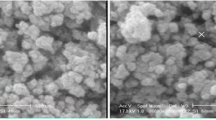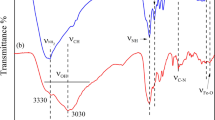Abstract
Arsenic is a widespread contaminant in soils and groundwater. While various iron-based materials have been studied for immobilizing arsenic in contaminated soils, the feasibility of stabilized iron-based nanoparticles has not been reported. This study investigates the effectiveness of using three types of starch-stabilized iron-based nanoparticles, including zero-valent iron (ZVI), iron sulfide (FeS), and magnetite (Fe3O4), for immobilization of arsenic in two representative As-contaminated soils (an orchard soil and a fire range soil). To test the effect of the nanoparticles on the arsenic leachability, As-contaminated soils were amended with the nanoparticles at various Fe/As molar ratios (5:1–100:1) and contact time (3 and 7 d). After three days’ treatments of a field-contaminated sandy soil, the PBET-based bioaccessibility of As decreased from an initial (71.3±3.1)% (mean±SD) to (30.9±3.2)% with ZVI, (37.6±1.2)% with FeS, and (29.8± 3.1)% with Fe3O4 at an Fe/As molar ratio of 100:1. The TCLP-based leachability of arsenic in a spiked fire range soil decreased from an initial (0.51±0.11)% to (0.24±0.03)%, (0.27±0.04)% and (0.17±0.04)% by ZVI, FeS, and Fe3O4 nanoparticles, respectively. The Fe3O4 nanoparticles appeared to be more effective (5% or more) than other nanoparticles for immobilizing arsenic. When the two soils were compared, the treatment is more effective on the orchard soil that has a lower iron content and higher initial leachability than on the range soil that already has a high iron content. These results suggest that these innocuous iron-based nanoparticles may serve as effective media for immobilization of As in iron-deficient soils, sediments or solid wastes.
Similar content being viewed by others
References
Davis A, Sherwin D, Ditmars R, et al. An analysis of soil arsenic records of decision. Environ Sci Technol, 2001, 35: 2401–2406
Fendorf S, La Force M J, Li G C. Temporal changes in soil partitioning and bioaccessibility of arsenic, chromium, and lead. J Environ Qual, 2004, 33: 2049–2055
Smith E, Naidu R, Alston A M. Arsenic in the soil environment: A review. Adv Agron, 1998, 64: 149–195
Davis A, Ruby M V, Bloom M, et al. Mineralogic constraints on the bioavailability of arsenic in smelter-impacted soils. Environ Sci Technol, 1996, 30: 392–399
Dixit S, Hering J G. Comparison of arsenic (V) and arsenic (III) sorption onto iron oxide minerals: Implications for arsenic mobility. Environ Sci Technol, 2003, 37: 4182–4189
Ford R G. Rates of hydrous ferric oxide crystallization and the influence on coprecipitated arsenate. Environ Sci Technol, 2002, 36: 2459–2463
Fuller C C, Davis J A, Waychunas G A. Surface-chemistry of ferrihydrite 2. Kinetics of arsenate adsorption and coprecipitation. Geochim Cosmochim Acta, 1993, 57: 2271–2282
Grossl P R, Eick M, Sparks D L, et al. Arsenate and chromate retention mechanisms on goethite.2. Kinetic evaluation using a pressure-jump relaxation technique. Environ Sci Technol, 1997, 31: 321–326
Jain A, Raven K P, Loeppert R H. Arsenite and arsenate adsorption on ferrihydrite: Surface charge reduction and net OH-release stoichiometry. Environ Sci Technol, 1999, 33: 1179–1184
Manceau A. The mechanism of anion adsorption on iron-oxides evidence for the bonding of arsenate tetrahedra on free Fe(O,OH) edges. Geochim Cosmochim Acta, 1995, 59: 3647–3653
Sherman D M, Randall S R. Surface complexation of arsenie(V) to iron(III) (hydr)oxides: Structural mechanism from ab initio molecular geometries and EXAFS spectroscopy. Geochim Cosmochim Acta, 2003, 67: 4223–4230
Waychunas G A, Davis J A, Fuller C C. Geometry of sorbed arsenate on ferrihydrite and crystalline FeOOH-reevaluation of EXAFS results and topological factors in predicting sorbate geometry, and evidence for monodentate complexes. Geochim Cosmochim Acta, 1995, 59: 3655–3661
Waychunas G A, Rea B A, Fuller C C, et al. Surface-chemistry of ferrihydrite.1. EXAFS studies of the geometry of coprecipitated and adsorbed arsenate. Geochim Cosmochim Acta, 1993, 57: 2251–2269
Beak D G, Basta N T, Scheckel K G, et al. Bioaccessibility of arsenic (V) bound to ferrihydrite using a simulated gastrointestinal system. Environ Sci Technol, 2006, 40: 1364–1370
Nikolaidis N P, Dobbs G M, Lackovic J A. Arsenic removal by zero-valent iron: Field, laboratory and modeling studies. Water Res, 2003, 37: 1417–1425
Su C M, Puls R W. Arsenate and arsenite removal by zerovalent iron: Effects of phosphate, silicate, carbonate, borate, sulfate, chromate, molybdate, and nitrate, relative to chloride. Environ Sci Technol, 2001, 35: 4562–4568
Su C M, Puls R W. Arsenate and arsenite removal by zerovalent iron: Kinetics, redox transformation, and implications for in situ groundwater remediation. Environ Sci Technol, 2001, 35: 1487–1492
Fendorf S, Eick M J, Grossl P, et al. Arsenate and chromate retention mechanisms on goethite.1. Surface structure. Environ Sci Technol, 1997, 31: 315–320
Huber D L. Synthesis, properties, and applications of iron nanoparticles. Small, 2005, 1: 482–501
Jegadeesan G, Mondal K, Lalvani S B. Arsenate remediation using nanosized modified zerovalent iron particles. Environ Prog, 2005, 24: 289–296
Zhang W X. Nanoscale iron particles for environmental remediation: An overview. J Nanopart Res, 2003, 5: 323–332
Chen S S, Hsu H D, Li C W. A new method to produce nanoscale iron for nitrate removal. J Nanopart Res, 2004, 6: 639–647
Joo S H, Feitz A J, Waite T D. Oxidative degradation of the carbothioate herbicide, molinate, using nanoscale zero-valent iron. Environ Sci Technol, 2004, 38: 2242–2247
Yang G C C, Lee H L. Chemical reduction of nitrate by nanosized iron: Kinetics and pathways. Water Res, 2005, 39: 884–894
Cumbal L, Sengupta A K. Arsenic removal using polymer-supported hydrated iron (III) oxide nanoparticles: Role of Donnan membrane effect. Environ Sci Technol, 2005, 39: 6508–6515
Kanel S R, Greneche J M, Choi H. Arsenic (V) removal kom groundwater using nano scale zero-valent iron as a colloidal reactive barrier material. Environ Sci Technol, 2006, 40: 2045–2050
He F, Zhao D Y. Preparation and characterization of a new class of starch-stabilized bimetallic nanoparticles for degradation of chlorinated hydrocarbons in water. Environ Sci Technol, 2005, 39: 3314
Ponder S M, Darab J G, Bucher J, et al. Surface chemistry and electrochemistry of supported zerovalent iron nanoparticles in the remediation of aqueous metal contaminants. Chem Mater, 2001, 13: 479
Raveendran P, Fu J, Wallen S L. Completely green synthesis and stabilization of metal nanoparticles. J Am Chem Soc, 2003, 125: 13940–13941
He F, Zhao D. Manipulating the size and dispersibility of zerovalent iron nanoparticles by use of carboxymethyl cellulose stabilizers. Environ Sci Technol, 2007, 41: 6216–6221
He F, Zhao D, Liu J, et al. Stabilization of Fe-Pd nanoparticles with sodium carboxymethyl cellulose for enhanced transport and dechlorination of trichloroethylene in soil and groundwater. Ind Eng Chem Res, 2007, 46: 29
Ruby M V, Schoof R, Brattin W, et al. Advances in evaluating the oral bioavailability of inorganics in soil for use in human health risk assessment. Environ Sci Technol, 1999, 33: 3697–3705
Akhter H, Cartledge F K, Miller J, et al. Treatment of arseniccontaminated soils. I: Soil characterization. J Environ Eng-ASCE, 2000, 126: 999–1003
Jing C Y, Liu S Q, Patel M, et al. Arsenic leachability in water treatment adsorbents. Environ Sci Technol, 2005, 39: 5481–5487
Miller J, Akhter H, Cartledge F K, et al. Treatment of arsenic-contaminated soils. II: Treatability study and remediation. J Environ Eng-ASCE, 2000, 126: 1004–1012
Yang J K, Barnett M O, Jardine P M, et al. Adsorption, sequestration, and bioaccessibility of As(V) in soils. Environ Sci Technol, 2002, 36: 4562–4569
Si S, Kotal A, Mandal T K, et al. Size-controlled synthesis of magnetite nanoparticles in the presence of polyelectrolytes. Chem Mater, 2004, 16: 3489–3496
Liang Q, Feng Y, Zhao D. In-situ immobilization of arsenic in sediment by stabilized magnetite nanoparticles. Water Res, in review
Xu W, Akins D L. Reverse micellar synthesis of CdS nanoparticles and self-assembly into a superlattice. Mater Lett, 2004, 58: 2623
Xiong Z, He F, Zhao D, et al. Immobilization of mercury in sediment by stabilized iron sulfide (FeS) nanoparticles. Water Res, 2009, 43: 5171
Yang J K, Barnett M O, Zhuang J, et al. Adsorption, oxidation, and bioaccessibility of As (III) in soils. Environ Sci Technol, 2005, 39: 7100–7108
Subacz J L. Decreasing Arsenic Bioaccessibility with Iron Amendments. Doctor Dissertation. Auburn: Auburn University, 2004
Waychunas G A, Kim C S, Banfield J F. Nanoparticulate iron oxide minerals in soils and sediments: Unique properties and contaminant scavenging mechanisms. J Nanopart Res, 2005, 7: 409–433
Gao Y, Mucci A. Individual and competitive adsorption of phosphate and arsenate on goethite in artificial seawater. Chem Geol, 2003, 199: 91–109
Cornell R M, Schwertmann U. Iron Oxides. New York: Wiley-VCH, 1996
Bang S, Johnson M D, Korfiatis G P, et al. Chemical reactions between arsenic and zero-valent iron in water. Water Res, 2005, 39: 763
Bostick B C, Chen C, Fendorf S. Arsenite retention mechanisms within estuarine sediments of Pescadero, CA. Environ Sci Technol, 2004, 38: 3299–3304
Bostick B C, Fendorf S. Arsenite sorption on troilite (FeS) and pyrite (FeS2). Geochim Cosmochim Acta, 2003, 67: 909–921
He F, Zhang M, Qian T, et al. Transport of carboxymethyl cellulose stabilized iron nanoparticles in porous media: Column experiments and modeling. J Colloid Interface Sci, 2009, 334: 96–102
Author information
Authors and Affiliations
Corresponding author
About this article
Cite this article
Zhang, M., Wang, Y., Zhao, D. et al. Immobilization of arsenic in soils by stabilized nanoscale zero-valent iron, iron sulfide (FeS), and magnetite (Fe3O4) particles. Chin. Sci. Bull. 55, 365–372 (2010). https://doi.org/10.1007/s11434-009-0703-4
Received:
Accepted:
Published:
Issue Date:
DOI: https://doi.org/10.1007/s11434-009-0703-4




